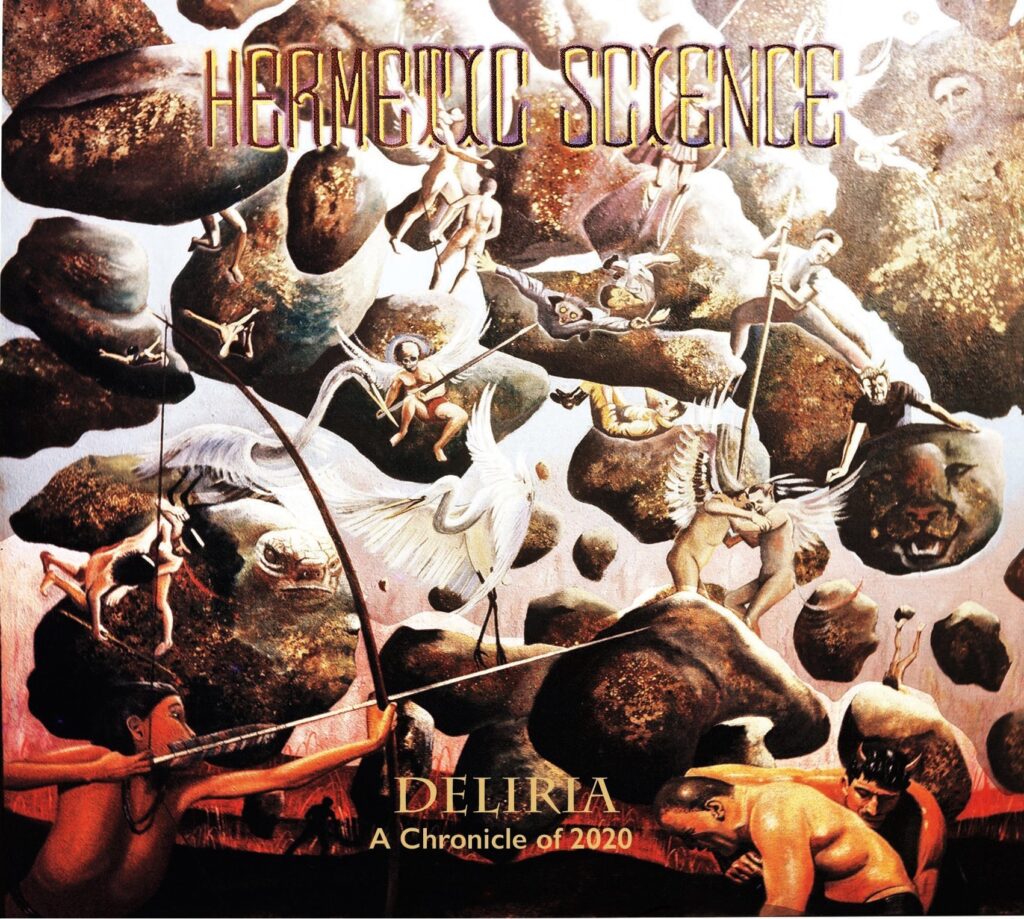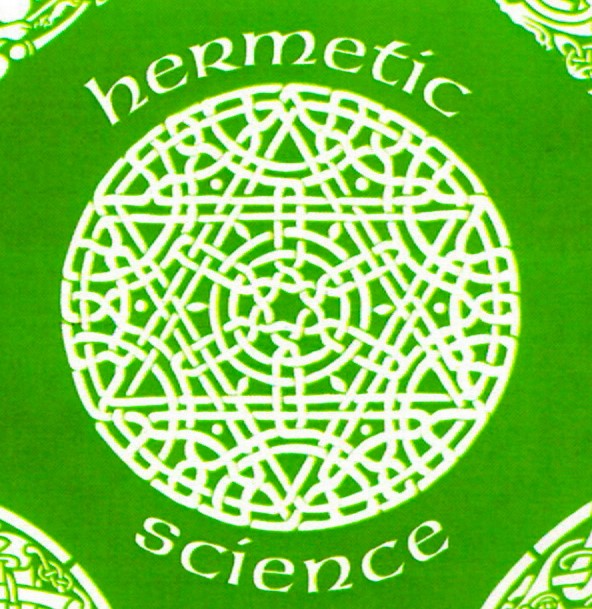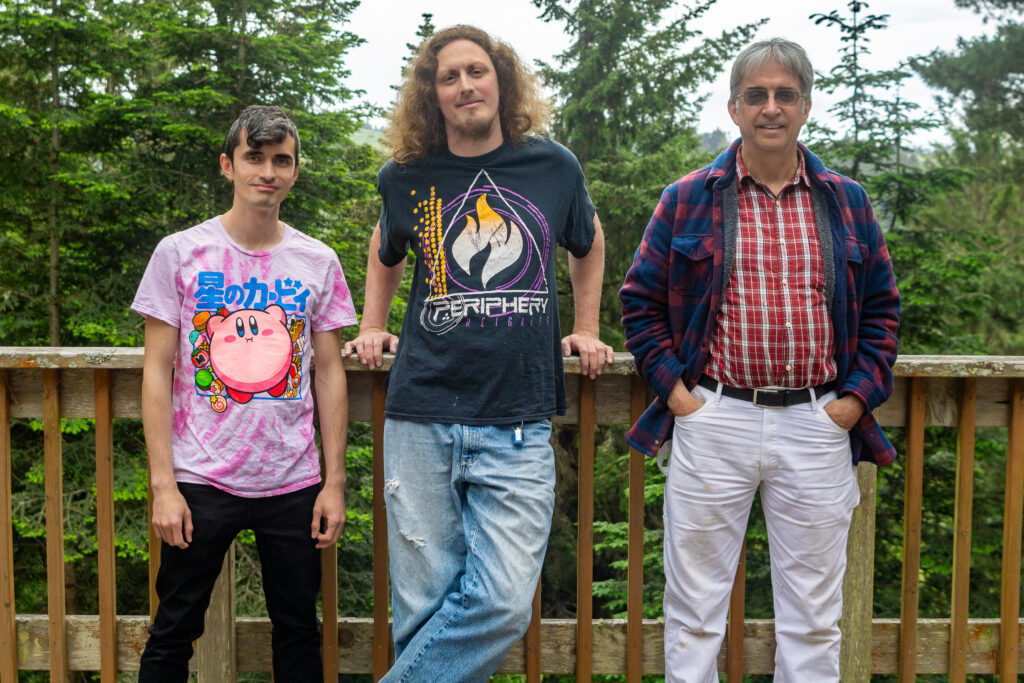Welcome to today’s interview featuring the remarkable instrumental band, Hermetic Science. Since their formation in 1996, Hermetic Science has carved out a unique niche in the realm of progressive rock, captivating audiences with their fusion of prog-psych-classical-jazz-medieval-eastern influences. Always maintaining a trio format, the band’s sound initially revolved around the remarkable vibes and marimba work of Edward Macan, later evolving to showcase his prowess on keyboards.
Today, we delve into the fascinating journey of Hermetic Science, particularly focusing on their latest release, “Deliria: A Chronicle of 2020.” This album marks their triumphant return after a 15-year hiatus, offering listeners their heaviest, darkest, and most cohesive musical endeavor yet. With themes that continually evolve and draw from a diverse array of influences, including 60s hard bop, 80s metal, 90s trance, and even horror movie motifs, “Deliria” serves as a haunting reflection of the tumultuous events of 2020.
Join us as we unravel the creative process, inspirations, and musical odyssey of Hermetic Science, as they continue to push the boundaries of progressive rock and captivate audiences with their unparalleled sonic tapestries.
Can you provide more insights into Hermetic Science’s evolution from your debut album, where vibes and marimba played a significant role, to the present where keyboards have taken precedence?
On our self-titled first album, we were essentially a vibes (occasionally marimba) power trio playing a blend of ECM-style jazz-rock and seventies prog. While I still like a lot of that music, which has a shadowy, mystic vibe all its own, the idea of doing a second album with the same instrumentation seemed somewhat dogmatic, so on Prophesies, I began cautiously blending analog keyboards—Hammond, ARP String ensemble, Moog—into our instrumentation, and our sound shifted toward an edgy chamber rock. By the third album, En Route, the closest thing we ever did to a straight up seventies prog rock revival album, the analog keyboards were beginning to push the mallets into the sonic background, There was a seven year gap between En Route and These Fragments I Have Shored Against My Ruins, and one of the things I decided during that period is that I was through with analog keyboards, which I had come to associate with the retro mindset that seemed to have seized the prog rock scene by that point. I used only digital keyboards on These Fragments, and introduced a number of post-rock influences to our sound, including extensive use of e-bowed bass. The mallets also had somewhat of a renaissance on that album. On our new album Deliria, the vibes retreat into the sonic background—there isn’t any marimba at all—and the sound of both keyboards and bass become considerably heavier in order to do the subject matter justice, as I explain below.

How has the band’s stylistic foundation evolved over the years, especially considering your unique blend of prog-psych-classical-jazz-medieval-eastern fusion on the debut album?
In a sense, I don’t think we’ve ever strayed from that formula, but we have adjusted the proportions of the ingredients with each new album. As I said, the debut album is very much influenced by ECM jazz, but there is also an Eastern influences and something hallucinatory, indeed psychedelic, about the heavily reverberating vibes on “Fire Over Thule” and “Trisagion.” The second album somewhat tamps down the jazz and Eastern influences and ups the influence of twentieth century classical music. As I said, the third album is the closest we ever came to a straight-ahead seventies prog rock revival album, with lots of the mainstream symphonic classical influences, although “Raga Hermeticum” was our most Eastern work of all—pretty much straight-ahead Raga-Prog. On our fourth, These Fragments, I introduced post-rock influences even while attempting to do justice to all our earlier preoccupations, although other than the final track, “The Second Coming,” it is a bit less dissonant and more romantic than our first three albums. Our new one is, unintentionally, something of a fusion or our earlier preoccupations as well—besides the strong twentieth century classical and modern jazz influences, there are also essences of psych, medieval, and Eastern.
Could you elaborate on the significance of your keyboard work becoming more prominent in the band’s sound, with vibes and marimba taking on a textural role over time?
I think I addressed this in my answer to the first question.
“Deliria: A Chronicle of 2020” is Hermetic Science’s fifth studio album and first in 15 years. What led to such a long gap between albums, and how has Hermetic Science changed or matured during this period?
After These Fragments was released in 2008, I thought Hermetic Science might be done. It wasn’t immediately clear to me how we might top it, and I didn’t want to release another album without a clear sense that it would be a step forward. And I was haunted by the dissonant chord that ended the final track of that album, “The Second Coming,” and wondered, what is the answer to that chord? Solving that riddle seemed to be the key to Hermetic Science’s continuation. It was not until the late 2010s I concocted another equally dissonant chord that I realized would answer the concluding chord of These Fragments, and would serve as the basis of a new album. Once 2020 rolled around and I started composing the album in earnest, I realized the new chord would symbolize the turbulence and agony of the New Era that 2020 seemed to inaugurate, and the album developed from there, especially once I saw how the new album would represent a step forward from our previous work: it would be more integrated and cohesive than any album Hermetic Science had released before.
The description mentions that “Deliria” is the band’s heaviest, darkest, and most cohesive album. What musical elements contribute to this heaviness and darkness, and how do they differ from the band’s previous works?
Deliria uses the octatonic and whole-tone scales more than any previous Hermetic Science album, giving the melodies and chords a “spiky,” dissonant sound. No previous Hermetic Science album is as synth- and Hammond organ-heavy as Deliria, and on no previous Hermetic Science album did the Hammond ever sound this intense: you’ll need to search a while to find a more dire Hammond sound than the opening of “Big Lie.” While arranging Deliria, I spent some time listening to the two Death Organ albums, and while I didn’t manage to totally nail Wibarj’s organ sound—his “infernal voix celeste” setting is inimitable—I think I definitely got my own angry Hammond thing happening. I also spent a lot of time listening to late sixties psych, particularly the Fire Suite from The Crazy World of Arthur Brown, during the album’s arrangement phase, and on Deliria I arranged the keyboards in such a way that my right hand plays organ or synth leads, while my left hand plays an accompanying figure in the low register of the piano that is independent of the bass line. As a result, there is both a lot of bass register presence, and a lot of density to the arrangements, with two independent keyboard parts, one of them low, and an independent bass line. I think all these factors combine to make Deliria a substantially heavier listening experience than our previous four studio albums.

The themes of the first two tracks on “Deliria” are mentioned to be continuously transformed. Can you provide more details on how these themes evolve throughout the album, and what inspired this continuous transformation?
This is the first Hermetic Science album to feature only music written specifically for the album, and to feature the tracks in the precise order they were completed. Therefore, each track is both a new chapter to the unfolding story, and a commentary on the tracks that came before. The dissonant chord that opens the album, heard first on spacey synth, then throughout the piano prelude, symbolizes the darkness and chaos of 2020. The second track, “Poison Seeds,” introduces three additional musical ideas: the melancholy theme of the first section, the mysterious three-note motif that opens the second section (3:02), and the urgent rising chord progression from 5:12 on. Most of what comes after derives from these musical gestures. “The Mighty MAGA March of Doom,” “Minneapolis 05-25-20,” and “In the Dark Shadow of the Big Lie” all develop out of the three-note motif that opens the second section of “Poison Seeds,” with “Minneapolis” and “Dark Shadows” also transforming the urgent rising chord progression of “Poison Seeds” at their respective climax points. The melancholic theme that opens “Poison Seeds” returns in a doomier, gloomier version at the climax of “The Great COVID-19 Rave of 2020,” after which ghostly versions of the main themes of “COVID-19 Rave” and “Mighty MAGA March of Doom” appear in counterpoint. “Kyrie Eleison” is based on a short scrap of melody drawn from the opening Prelude. “Armageddon Warm” is derived almost entirely from the chord that opens the album, with the exception of the middle section, which is drawn from a scrap of theme from a quiet section of “COVID-19 Rave.” The “battle music” of “Big Lie” (5:52-7:51) features thematic essences of all previous tracks. The final track consists of two sections, the “Agnus Dei” followed by the Main Theme Reprise; the “Agnus Dei” is in fact the Main Theme at a slower tempo, in a more irregular meter, using ritualistic keyboard patches.
What was the purpose of these transformations? Simply to suggest that all the crises that exploded in America in 2020—not just COVID, but the accelerating destruction of the planet, the delegitimation of science and democracy, the relegitimation of white supremacy and fascism—are interrelated.
The album draws inspiration from diverse sources such as 60s hard bop, 80s metal, 90s trance, and horror movie motifs. How seamlessly do these influences blend with the classic Hermetic Science sound, and what challenges or creative opportunities did the band encounter in incorporating such varied elements?
All these sources met two criteria: they had an affinity to existing elements of our sound, and they contributed to a specific sensibility we were seeking to convey. Hermetic Science’s stylistic foundation always has contained a jazz element, but Deliria may be the most prominently it has shown up since our debut album. If you listen to late sixties psych and early seventies prog, you notice they use elements of hard bop and free jazz to convey a sense of delirium, and that’s precisely the sense we used it in; I’m no McCoy Tyner, but I did my best to tap into the spirit of that music. Travis is a natural jazz drummer—his drumming reminds me a lot of Michael Giles—and I think that also contributed to the album’s jazz sensibility. In terms of the thrash influence, when the composition was complete, and we were approaching the arrangement stage, I spent some time listening to the two Death Organ albums, as I’ve already said, and Jeff Ruiz’s contributions also were important, as he has played in thrash bands, and his bass timbre has a spikier, more distorted sound than any previous Hermetic Science bassist. As for nineties trance, I always felt it had a very direct lineage to late sixties psych, to the point that when we were rehearsing “COVID-19 Rave” I told Jeff and Travis to listen to the Nice’s original version of “Rondo” and any Armin van Buren track they cared to for dual reference. In regards to the horror movie soundtrack influence—this whole album was conceived as a soundtrack to an imagined documentary of 2020 and therefore has a more cinematic aspect to it than any previous Hermetic Science album. Both Jeff and Travis are aficianados of the horror film soundtrack genre, more than I am, I daresay, so when I pointed to the places where we wanted a horror element (“Mighty MAGA March of Doom,” “Big Lie”), they invariably came through with suitable ideas.
The artwork for “Deliria” is created by Paul Whitehead, known for his work with Genesis and Van der Graaf Generator. How does the album’s visual representation complement or enhance the musical themes explored in “Deliria”?
I’ve had profound respect for Paul’s art ever since I first laid eyes on it back in the seventies, and I came to respect him equally as a person when I became acquainted with him in the early nineties while writing Rocking the Classics. I consider Paul to be the quintessential prog rock artist. What I’ve admired most about his work—which is quite varied in its iconography and means—is the intensity he always brings to it. Given the somewhat apocalyptic nature of Deliria, I wanted something powerful. I looked at a lot of artwork by other artists that just wasn’t doing it for me, then I saw Paul’s “Armageddon Warm,” and immediately contacted him. In turns out in 1975 he completed it for use on Armageddon’s debut (and as it turned out, only) album, but their record label, A & M, rejected it because it was “too dark.” Well, their loss was our gain, and I remain very thankful that 48 years later, he licensed its use to us. Once he heard the music, he suggested we include some of his imagery from his epic tableaux The Eight Deadly Sins, and I pretty much stepped out of the way and let him pick out the specific images that he felt fit the subject matter and music. That’s how that collaboration evolved.
Considering that “Deliria” documents the madness, mayhem, and folly of 2020, how do you use your music to convey these themes, and what role does the instrumental nature of your music play in expressing such concepts?
I hear Deliria as a soundtrack to a movie about 2020 that has yet to be made. Several of the tracks—the opening Main Theme, “The Mighty MAGA March of Doom,” “The Great COVID-19 Rave,” “Mineeapolis,” and “The Big Lie”—were very much conceived as cinematic shorts: that is, the music is intended to sketch the storyline implied by the title as vividly as possible. A few of the tracks, such as “Poison Seeds,” were more symbolic and general in terms of the ideas they expressed. As I explained above, the persistent transformation of a few musical themes in a wide variety of musical contexts across the album was central to our attempt to try to tell the story of 2020 as we understood it through the medium of instrumental rock music.
With the release of “Deliria,” how do you see your place in the contemporary music scene, and what do you hope listeners take away from this album in terms of experience and emotions?
Deliria attempts to express our vision of the worldwide crisis that emerged in 2020 using a 50-55 year old rock music style refracted through modern production, technology, and performance sensibilities. To the degree that Deliria helps listeners confront their own experience of this crisis and/or look at it from a new and different angle, we achieved what we set out to do.
For more about Hermetic Science visit the band’s website here.

